2 December, 2001

When I stepped on the sea ice (The seawater is below the ice), I turned back to catch a glimpse of our field camp beyond the moat. The tide was out, so it was relatively easy to cross this area without getting water in our boots. Dr. Korsun and I tended two dives today as Dr. Bowser and Dr. Alexander dove beneath 12-feet of ice to collect forams from the top one-centimeter of sediment at the bottom of the ocean. The first dive was at a nearby dive hole, but due to the weight of the gear, we used a Ski-Doo (snowmobile) to pull the gear by sled across the rough sea ice. One dive tank alone can weigh 45 pounds. The second dive later in the day was made from inside the dive hut. The dive hut is usually kept about 70 degrees Fahrenheit. The divers add three layers beneath their dry suits to provide warmth in the 28 degrees Fahrenheit water. They also wear warm socks and gloves under their dry suits. When tending the dives, we help the divers get suited up, as well as gather the equipment needed for the dive. We put flashers (lights) and an extra oxygen tank on the guide rope leading down into the dive hole for safety purposes.
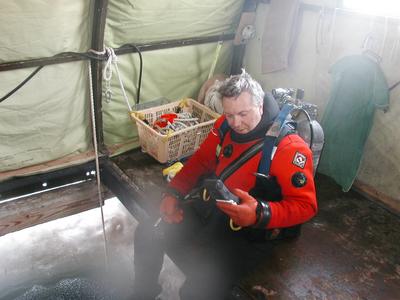
Dr. Bowser is checking his dive computer before making the dive in the dive hut. This device helps track current, maximum depth, and time spent underwater. It also keeps up with "allowable time" to be under water as well as "decompression stop" information. This information is important to track when diving, especially when diving in extreme conditions.

This dive computer is similar to the other, but it is worn as an aid to Dr. Neal Pollock=92s study of decompression in divers (See journal entry, November 18, 2001). Dr. Pollock brought these small dive computers (worn on the wrist) on the Ice for the 1999 and 2001 seasons. Dr. Pollock had both software and hardware to download the data for depth, underwater time, and decompression information for monitoring each dive.
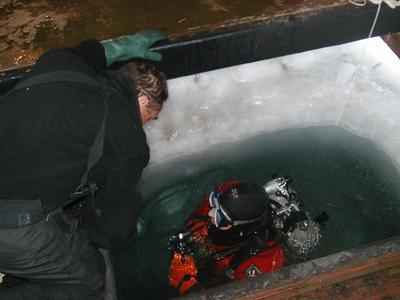
Dr. Bowser is getting ready to descend, while Dr. Korsun tends the dive from the surface. Dr Bowser confirms the current time, as well reaffirms the scheduled time he plans to resurface. This will be a 50-minute dive. Dr. Alexander will be making the dive with him. Before the divers go into the water, we will make a "com check" to establish communication with Mac Ops (McMurdo Operations). The radios must be operable at all times. If an emergency should arise, it is imperative that the hand-held VHF radios be charged and ready. In Antarctica, safety is an ultimate concern at all times.
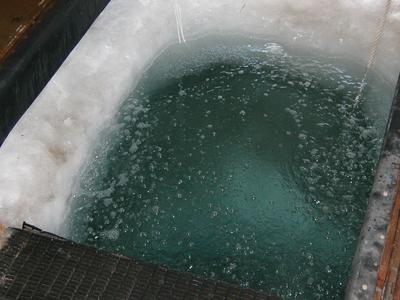
Once communication has been established, the divers will tell the people tending the dive what time to expect to see bubbles. This will indicate that the divers are at their safety stop. Within 10 minutes, they will surface at the scheduled time. If a diver goes 15 to 20 minutes beyond their scheduled time, Mac Ops will be notified to put the Science Dive Coordinator for Antarctica on alert. The divers adhere strictly to their scheduled times.

Dr. Korsun is working the airlift, which has been turned on by the divers from below the ice. The airlift works like a vacuum as the top one-centimeter of sediment is carefully suctioned up from a designated area on the seafloor.

The top sieve traps bigger invertebrates in the top tray, while the smaller 1mm sieve will collect microscopic foram-size organisms. The water gushes through the pipes into the sieves.
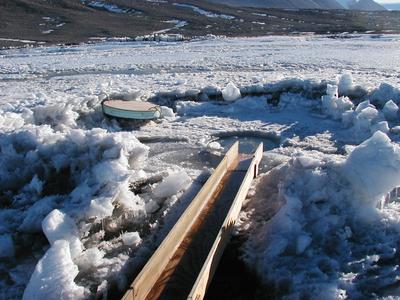
The sludge and water will travel along a trough before going back into the sea. One day, the cover was frozen into place on this outside hole. As I walked by, I could hear heavy breathing. I looked at a little gnawed opening next to the cover to find a nose sticking through the hole. A Weddell Seal had chewed a small opening in the ice to get air. Antarctica is a land of many surprises!

Dr. Korsun is preparing the forams and other microorganisms taken from this sieved material to be sorted and analyzed at a later time. This photo shows the airlift as it comes out of the other dive hole and into the basin to be sieved. (The dive hut has two dive holes). I assisted Dr. Korsun while we waited for the divers to resurface.
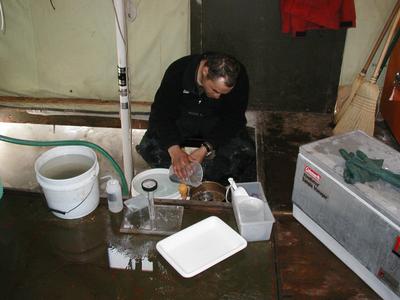
Dr. Korsun is preparing the forams for the lab. It takes time and a lot of work to get to the science. The forams and microorganisms are kept alive in bottles of seawater. They must be kept cold (around 0 to -2 degrees Celsius). The water can not get over 6 degrees Celsius, and they must have seawater (not freshwater) to survive. I went out to collect slush (ice) to fill the cooler to store the forams at the correct temperature.

Dr. Korsun and I left about 8 p.m. to pick up the melter from the Herbertson Glacier area. Our team recently did a drill/melt (See journal entry: November 25) to make a dive hole in this area, and we needed to bring the melter back to camp. It is light 24 hours of day during the austral summer in Antarctica, so we didn=92t worry about darkness during the late night hours. Although the picture does not do this justice, Dr. Korsun is up ahead driving past a huge iceberg. Trying to capture the feeling of being in a wilderness area, as well as the size of this area, is lost in the picture. Even so, I had to stop for a second just to get a picture. Dr. Korsun and I each took a Ski-Doo with the needed gear, including candy bars and hot coffee. We had a 90-minute drive across the rough sea ice to reach our destination. We took the required hand-held radio to maintain contact with base camp after we had established a scheduled time to return to Explorers Cove.

The scenery was spectacular as we passed glaciers, massive icebergs, and Mt. Erebus. By the time we got to the Ferrar Glacier, we could see clouds moving in over the mountains. I had the eerie feeling that I was on another planet. I not only felt like I was in Antarctica, one of the most remote places on Earth, but I "felt" Antarctica. This will be an experience that will stay with me the rest of my life. Of course, being Antarctica, nothing ever seems to work when you expect it. When we arrived at the melter, we found the runner needed to have some repairs before it could be moved.
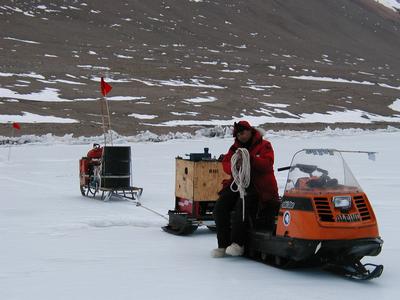
Dr. Korsun is making last minute adjustments before we try to move the melter. It was a slow process, and we had to call back to our field camp to reschedule our arrival time back in camp. We had to stop partway back because the melter couldn=92t go any further. It would need another part. We arrived back in camp about 2 a.m., then unloaded the sled. Dr. Bowser was up waiting for us at the dive hut. He couldn=92t go to bed until he knew we were safely back as scheduled. He had spent his time preparing specimens. We were all tired, yet in Antarctica everyone works as a team. This was felt from the first day that I met my team members on Dr. Bowser=92s research project.
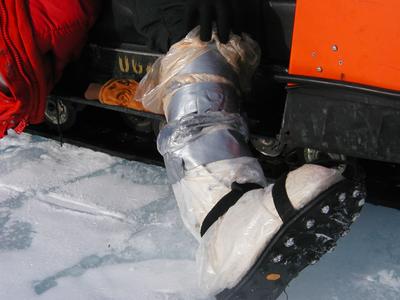
The only pair of waders left in McMurdo was an XX Large. I checked them out, but when I tried to wear them, the waist came up to my neck. In Antarctica, the words "I can't" or "I don't have" just aren't heard. When Dr. Bowser saw my predicament, he told me to go fashion some boots out of plastic bags and duck tape. Actually, they worked quite well during low tide, or in ankle deep water. Since we arrived back in camp during high tide, I dreaded crossing the moat. The water came in over my knees and went into my boots. It definitely gave me an appreciation for what the divers experienced every day in the 28 degree Fahrenheit water. It was so cold! Despite the cold and the early morning hours (We didn't get to bed until 3:30 a.m.), this was one of my most Antarctic and appreciated experiences. (Thank you Dr. Bowser and Dr. Korsun)
Contact the TEA in the field at
.
If you cannot connect through your browser, copy the
TEA's e-mail address in the "To:" line of
your favorite e-mail package.
|
